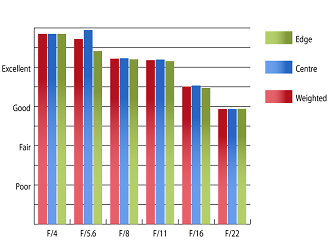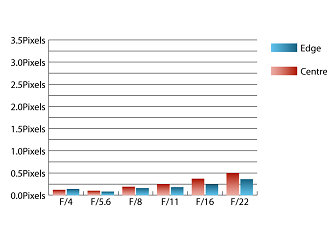Canon EF 400mm f/4 DO IS II USM Lens Review
Canon EF 400mm f/4 DO IS II USM Performance
As you might expect from a lens that commands such a high price, this lens performs superbly as far as sharpness is concerned. Diffraction appears to be the ceiling for performance, with this lens delivering outstanding sharpness across the frame at maximum aperture. Although sharpness in the centre of the frame peaks at f/5.6, on the whole, performance is reduced gradually as the aperture is stopped down. It would be a big ask for Canon to defeat physics to improve performance in this respect. Sharpness remains excellent across the frame, until the aperture is stopped down beyond f/11.
How to read our charts
The blue column represents readings from the centre of the picture frame at the various apertures and the green is from the edges. Averaging them out gives the red weighted column.The scale on the left side is an indication of actual image resolution. The taller the column, the better the lens performance. Simple.
For this review, the lens was tested on a Canon EOS 5D Mark III using Imatest.
Chromatic aberrations are extremely well controlled, just about reaching a half of a pixel width at f/22 in the centre of the frame. This low level should pose no issues, even in large prints and harsh crops from the edges of the frame.
How to read our charts
Chromatic aberration is the lens' inability to focus on the sensor or film all colours of visible light at the same point. Severe chromatic aberration gives a noticeable fringing or a halo effect around sharp edges within the picture. It can be cured in software.Apochromatic lenses have special lens elements (aspheric, extra-low dispersion etc) to minimise the problem, hence they usually cost more.
For this review, the lens was tested on a Canon EOS 5D Mark III using Imatest.
Falloff of illumination towards the corners is well controlled for a lens of this focal length and aperture. At f/4 the corners of the frame are 1.04 stops darker than the image centre and illumination is visually uniform with the lens stopped down to f/8.
Distortion is extremely mild with Imatest detecting only 0.23% pincushion distortion. This level of distortion is so low, that there should be no need to apply corrections in image editing software afterwards.
A deep circular hood is supplied as standard with this lens, which does an excellent job of shading the lens from extraneous light that may cause issues with flare. Even without the hood, the lens is extremely resistant to flare and contrast remains high when shooting into the light.
Value For Money
Due to the use of diffractive optics and professional 'L series' build quality, the price of this lens sits firmly at the exotic end of the scale as far as Canon's range of telephoto lenses are concerned. In fact, save another £700 and you can have Canon's 400mm f/2.8 lens.
Those with an eye for a bargain will see that some places still have stock of the first version of this 400mm f/4 DO lens. With this lens being priced from around £4500, it would seem silly to ignore if you're in the market for a lens like this.
Add your message
Please login here or if you've not registered, you can register here. Registering is safe, quick and free.
photodo Stats
428 MTF tests
74 in-depth photodo reviews
100+ users join each day
Help the lens community by reviewing or rating a lens today via our lens search
Latest Lens Reviews
- Chinon 28mm f/2.8 Vintage Lens Review
- Canon EF 70-200mm f/4L IS II USM Lens Review
- Samyang AF 85mm f/1.4 EF Review
- Sigma 70mm f/2.8 DG Macro Art Review
- Samyang AF 24mm f/2.8 FE Review
- Meike 50mm f/1.7 Review
- Tamron 70-210mm f/4 Di VC USD Review
- Lensbaby Burnside 35mm f/2.8 Review
- Asahi Super Takumar 50mm f/1.4 Review
- Asahi Super-Multi-Coated Takumar 135mm f/3.5 Review


